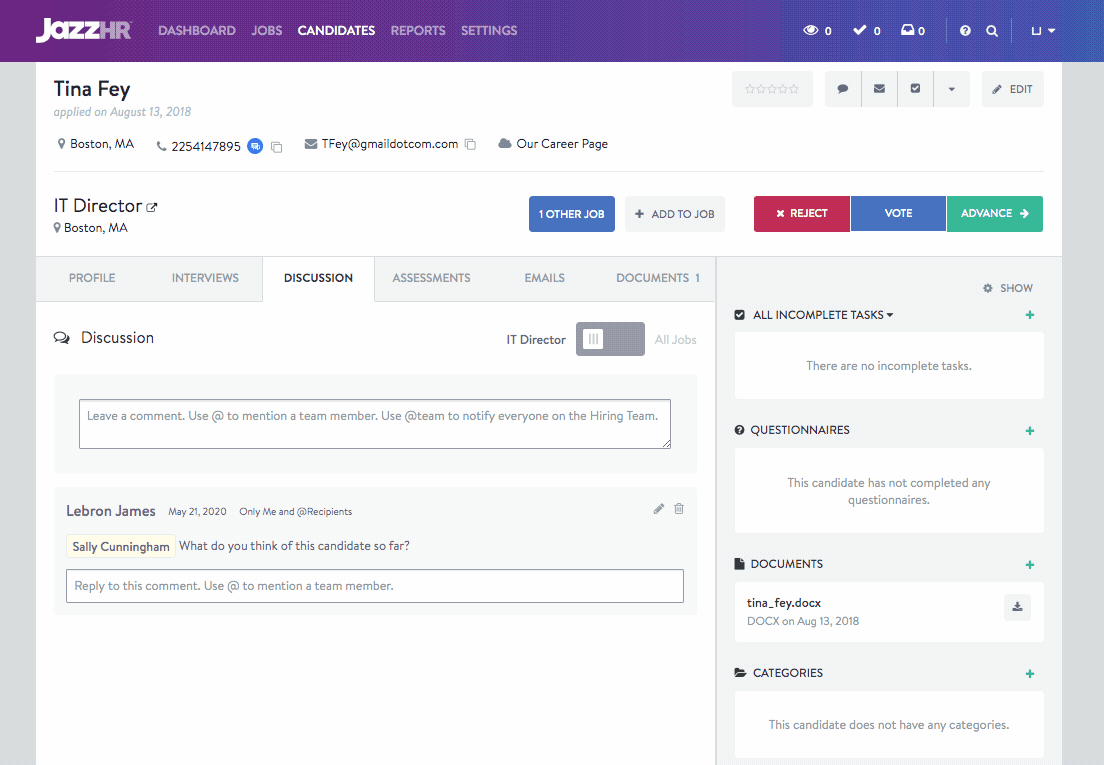Key takeaways:
Check out our Recruitment Software Guide for solutions to help with your talent acquisition needs.
How to conduct a job interview: 9 tips for success
The candidate interview is one of the most crucial stages of the hiring process and one that many employers get wrong. Failing to conduct an interview properly means missing out on a great hire and potentially damaging your company’s brand and reputation.
So, if you’ve reviewed résumés, completed pre-interview phone and skill assessments, and narrowed down your candidate list, consider the following tips before conducting your interview:
- Prep interview questions beforehand.
- Decide between an in-person or virtual interview.
- Get others on the team involved.
- Make the candidate comfortable.
- Take interview notes.
- Use the STAR method.
- Assess for values fit instead of culture fit.
- Let the candidate ask questions.
- Market the role.
Also read: Conducting an Effective Exit Interview: Tips & Best Practices
1. Prep interview questions beforehand
Base your interview questions on structured hiring goals, job descriptions, skills assessments, and historically great candidates. Most of these questions should be identical and asked in the same order to promote consistency, mitigate bias, and improve interview efficiency.
You should not ask questions to candidates on-the-fly during the interview since you could miss out on critical evaluative questions. In addition, you could inadvertently ask illegal questions that violate laws such as Title VII of the Civil Rights Act or Americans with Disabilities Act, including questions on immigration, pregnancy, marital, military, or disability status.
Many question categories exist, but the main ones include icebreaker, verification, skills-based, and behavioral or situational questions.
If you’re struggling to develop interview questions, our downloadable resource can help you get started.
2. Decide between an in-person or virtual interview
You can either host an interview in person or virtually. The role, workplace location, and schedules of the interviewer and interviewee will help determine what format is best.
For example, in-person interviews could be helpful for certain customer-focused jobs in industries such as hospitality, service, or manufacturing. Employers can assess how candidates interact with others and navigate the work environment.
Virtual interviews are typically the most convenient for both you and the candidate but require a level of technology accessibility for the candidate. Most recruitment and applicant tracking system (ATS) software includes easy scheduling capabilities, whether you’re hosting in-person or virtual interviews. Lever, for example, allows candidates to schedule their interviews.
Check out how Lever handles interview scheduling in the video below:
3. Get others on the team involved
Recruiters should not be the only individuals interviewing candidates, nor should hiring managers. Although recruiters can help facilitate these meetings and act as a touch point for candidates throughout the hiring process, they are not experts in the role.
Include a reliable employee in the interview process who can ask and answer insightful questions regarding the position’s day-to-day. This person may be the hiring manager or a current employee.
Whoever it is, ensure a diverse interview panel and limit it to no more than three to mitigate the chance of bias without overwhelming the interviewee.
4. Make the candidate comfortable
Stay in constant communication with the candidate before, during, and after the interview. In addition, remain transparent with them about interview expectations. For example, give them an idea of the questions they will receive, an interview schedule, the interview attendees, and the dress code.
If the interview is in-person, consider how to leverage the interview location to your and the interviewee’s advantage. For example, Brian Anders, HR director at WorkSmart Systems, uses settings outside the office to help make candidates feel more at ease, such as facility tours with would-be colleagues.
Neutral locations, such as restaurants or coffee shops, can also be a great way to gauge candidates’ personalities outside of a formal setting or provide a private environment for candidates interviewing for executive roles. Moreover, to Anders, food interviews are a “win-win because hiring managers will either find a great new employee or get a nice lunch.”
5. Take interview notes
Don’t rely on your memory; taking personal interview notes can help you remember key aspects of the conversation and what stood out to you. If you can, obtain permission from the candidate to record the meeting and use AI since these laws differ from state to state. Google Meet, for example, allows you to record the interview and use AI to transcribe the conversation.
An ATS can also help you keep track of notes and collaborate with other panelists before and after the interview. JazzHR, for instance, includes a discussion tab in every candidate profile to compare notes with other interviewers for evaluating the candidate’s chances of advancing to the next stage.

6. Use the STAR method
Candidates typically use the STAR method to prepare for interview questions, especially behavioral or situational questions. However, interviewers can also use this method to steer conversations with candidates, especially if they do not fully answer a question.
With the STAR method, you can dig deeper to understand how candidates’ past experiences impacted their previous companies and align them to the open position.
What is the STAR method? STAR stands for Situation, Task, Action, and Result. It’s a way of answering interview questions by explaining how you solved a situation in the past. Answers involve describing the situation, breaking it into its component tasks, explaining your actions, and then describing the end result.
7. Assess for values fit instead of culture fit
The best candidates will not be carbon copies of previous folks in the role. Assessing candidates during the interview to see if they’ll fit into your company’s culture can promote bias by favorably viewing candidates with similar backgrounds and inadvertently creating a homogenous workforce.
Instead, evaluate the candidate for values fit. Values fit allows you to see if the candidate holds similar values to your company and if their working style will accommodate it. It also leads to more diverse hires since it supports assessing candidates’ experiences and motivations rather than matching their backgrounds to current employees.
8. Let the candidate ask questions
Allow 15-20 minutes at the end of the interview for candidates to ask any questions they may have about the company or the position. Be prepared with answers to some common questions. If the candidate asks about the company’s history, the interview is not the time to Google answers.
Having multiple interviewers can also provide appropriate, in-depth answers. For instance, recruiters can provide information on hiring next steps while hiring managers can give context around typical workdays.
It is okay if candidates do not have questions at the end of the interview. Remember, the interview experience is stressful, so provide opportunities for candidates to reach out for follow-up questions later if necessary.
9. Market the role
If the candidate seems promising, underscore what makes your company stand out from competitors. Remember to be authentic and honest about your company and do not provide candidates with false expectations. This could tarnish your reputation and, in turn, your future recruiting strategies.
Focus on something other than your company’s benefits or perks packages too. Highlighting the little things your company does may make a difference for candidates.
For instance, at TechnologyAdvice, we have ways to publicly recognize employee achievements through Slack and our human resources management system (HRMS) so employees always feel appreciated for their efforts, whether big or small.
Ask great interview questions using our free guide
Developing effective interview questions is one of the most tedious aspects of the recruitment process, but it doesn’t have to be so complicated. Our guide includes a list of starting questions plus tips and tricks to create your own questions.
Download our interview question guide for free:
Find your next great hire
Whether this is your first interview or you’re a seasoned professional, following these tips can help you develop strong interview habits. You will also be able to find candidates faster while avoiding any bad hires.
Syncing your interviews with your recruitment software can help you easily capture interview notes and manage your candidate’s progression. By centralizing this data in one place, you can improve your time-to-fill and other recruitment metrics while ensuring a positive experience for your next great hire.
But if you’re unsure where to start, check out our Recruitment Software Guide for a comprehensive list of solutions.





